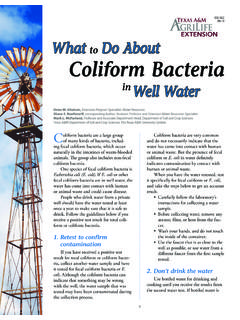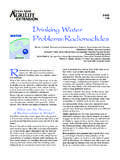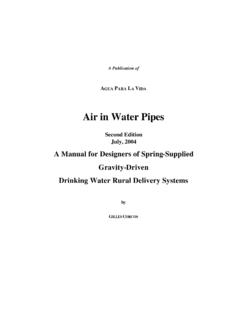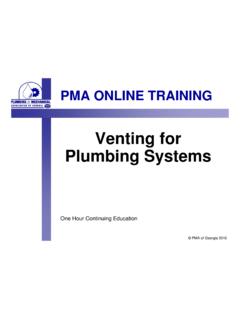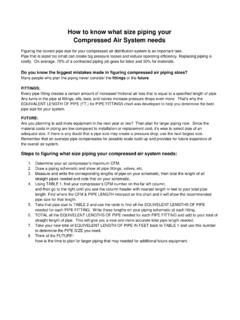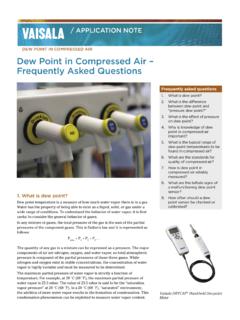Transcription of Drinking Water Problems: Corrosion - TWON
1 Drinking Water Problems: CorrosionMark L. McFarland, Tony L. Provin, and Diane E. Boellstorff*Professor and Extension Water Quality Coordinator, Professor and Extension Water Testing Laboratory Director, Assistant Professor and Extension Water Resources Specialist, Texas AgriLife Extension Service, The Texas A&M SystemCorrosion is one of the most common problems affecting domestic Water supplies. Chemical processes slowly dissolve metal, causing plumbing pipes, fixtures and Water -using equipment to deteriorate and fail. Corrosion can cause three types of damage: The entire metal surface gradually thins and red stains appear in iron or steel plumbing systems or blue-green stains in copper and brass plumbing systems (Fig.)
2 1). Deep pits appear that can penetrate pipe or tank walls. This type of Corrosion may not add significant amounts of iron or copper to the Water , but can eventually perforate a pipe or tank, and cause potentially major Water damage to a home or business (Fig. 2). Copper or other metals oxidize in a process similar to the rusting of steel. It often reduces Water flow through supply lines and destroys Water valves and other Water control surfaces, creating leaks inside and outside of valves and faucets. This type of Corrosion is not necessarily caused by Water chemistry, but by exposure to soil or other corrosive environments.
3 Figure 1. Corrosion at a connection on a Water heater indicated by the blue-green color. Figure 2. Pinhole leaks in copper tubing caused by internal Corrosion . E-6167/122 What health problems can Corrosion cause?Copper and lead can be toxic and can leach into tap Water in older or in new homes. This leaching is caused by Corrosion . Copper contamination can cause gastrointestinal problems in the short term and damage the liver and kidneys over time. Lead contamination can cause physical and mental development problems in children. In adults, it can lead to high blood pressure and kidney problems.
4 What levels are harmful?The Environmental Protection Agency has established primary Drinking Water standards for copper and lead ( ). The maximum allowable for copper is milligrams/liter; the maximum allowable for lead is milligrams/liter. Contaminants may be reported in milligrams/liter (mg/L) or parts per million (ppm); these units are equivalent. Iron and zinc also are usually present and can cause Water to have a metallic taste, but are not health concerns. How do I know if there is a Corrosion problem ?The most common symptoms of corrosive Water are: Cold Water tastes bitter at first use in the morning, and the taste improves after running the Water for a few seconds.
5 Blue-green stains in sinks and/or at the joints of copper piping. Water leaks in floor, wall or ceiling areas from pin-size or larger holes in metal pipes. If you suspect that your Water is corrosive, have it tested by a laboratory. Water -testing laboratories, including the Texas AgriLife Extension Service Soil, Water and Forage Testing Laboratory, test irrigation and/or livestock Water . Elevated copper, iron, or zinc in the Water can indicate ongoing Corrosion in a Water system. However, these tests only indicate a potential problem ; further testing is needed to determine the causes and severity of the Corrosion potential.
6 Two common tests can determine if Water is likely to be corrosive: the Langelier Saturation Index (LSI) and the Ryzner Stability Index (RSI).In order to use the LSI, a laboratory must measure pH, electrical conductivity, total dissolved solids, alkalinity, and total hardness. The LSI is typically negative or positive and only rarely zero. Negative values predict that the Water is more likely to be corrosive. Potentially corrosive Water typically has an LSI value 1 (mild) to 5 (severe). When the RSI is used, a value over indicates that the Water is probably corrosive; higher values are increasingly corrosive.
7 Not all laboratories offer the saturation or stability index. Contact the laboratory to discuss their services, pricing, and procedures for collecting, handling, and submitting samples. The Texas Commission on Environmental Quality maintains a list of laboratories certified to test Drinking Water : causes Corrosion ? Corrosion is a natural process that occurs when metals react with oxygen and form metal oxides. All Water contains some dissolved oxygen and is therefore somewhat corrosive. The rate of Corrosion depends on many factors including the Water s pH, electrical conductivity, oxygen concentration, and temperature.
8 In addition to Corrosion , metals dissolve when the Water is extremely low in dissolved salts and in the presence of certain Water -borne ions. This process causes the plumbing material to gradually dissolve. Though Corrosion and dissolution are fundamentally different, the result is similar and they are generally discussed as Corrosion . Acidity or low pHThe pH scale ranges from 0 to 14; a pH of represents the point where acid and alkaline materials are in balance. Water with a pH value below is considered acidic, while Water above is alkaline.
9 Alkalinity and pH often are confused. Total alkalinity refers to the total bases in Water that can neutralize acid. These include bicarbonates, carbonates, hydroxides, and some phosphates and 3silicates. Alkalinity is reported in milligrams per liter of calcium carbonate. Groundwater can be acidic or alkaline in pH, depending on several factors. Rainfall is typically acidic because it picks up carbon dioxide as it falls to the earth, forming carbonic acid. As Water percolates through the soil, it also can come in contact with acidic materials such as decaying organic matter.
10 Limestone (calcium carbonate) and dolomite (calcium magnesium carbonate) in the soil neutralize the acid and the Water is usually alkaline pH between 7 and 8 and hard due to the carbonates. If there is no limestone or dolomite, the groundwater will remain acidic with pH values between 6 and 7. Water that contains calcium or magnesium salts (hard Water ) is less corrosive, because the minerals that cause hard Water tend to coat and protect the inside of pipes. Soft Water that contains sodium salts does not coat the pipes and consequently is more corrosive.
